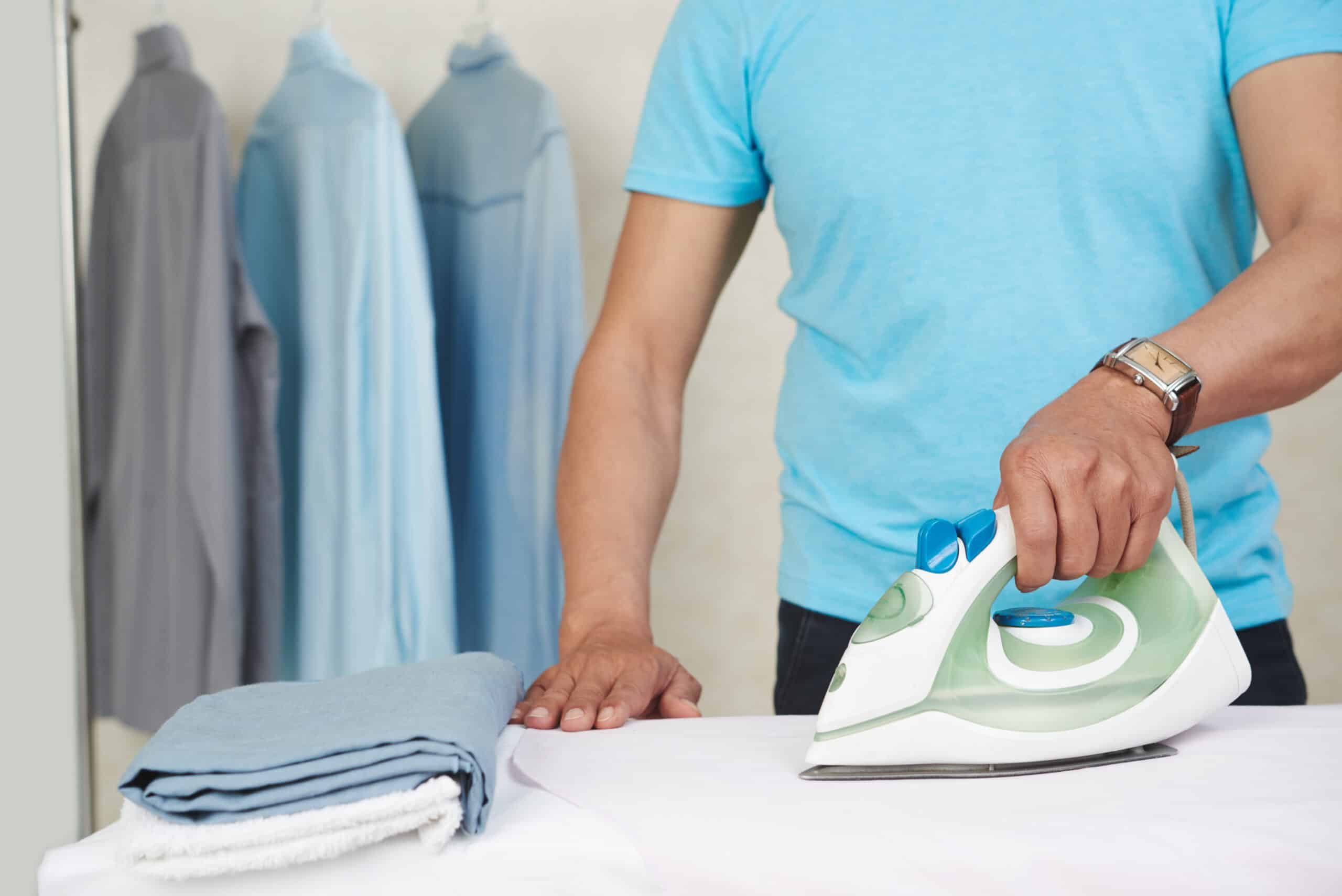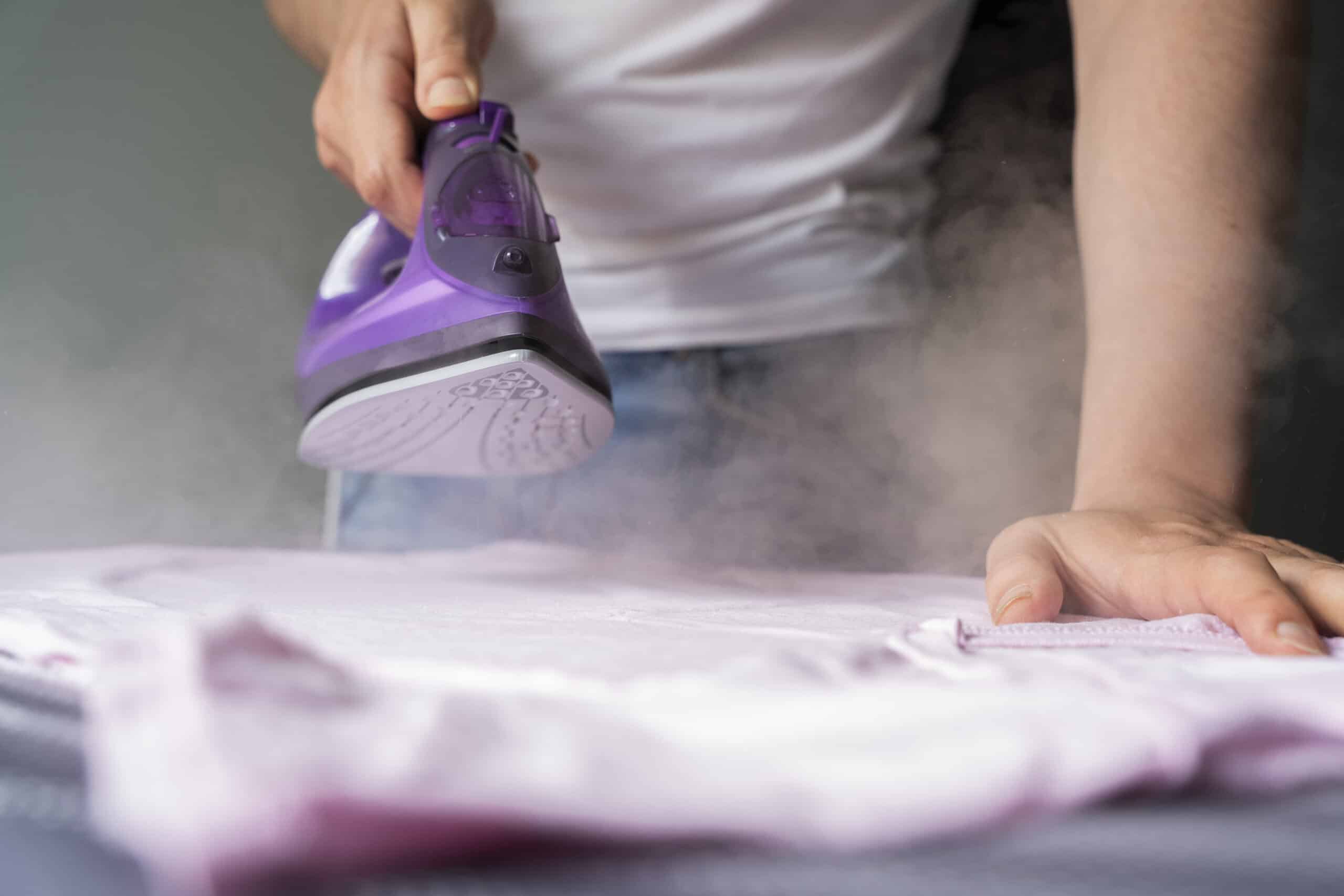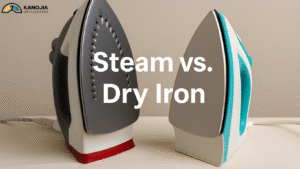With all the advances in ironing technology, it’s important to understand what differentiates these two types of irons, so you can make an informed decision about which one is best suited for your needs.
The decision between a steam iron vs. dry iron can significantly impact not only the efficiency of your ironing routine but also the longevity and appearance of your clothes.
Some swear by the simplicity of dry irons, while others favor the advanced technology and enhanced results of steam irons. The goal of this blog is to equip you with all the information you need to understand these two appliances thoroughly.
What Is a Dry Iron?

A dry iron is the traditional, straightforward ironing appliance that has been used for decades. The design of a dry iron is simple – it features a flat soleplate that heats up when plugged in, and the heat is directly applied to your clothes to remove wrinkles.
A key feature of dry irons is that they do not use water. This means there is no steam involved, and as a result, dry irons are generally lighter and simpler to handle. Their lightweight design can make them an excellent choice for individuals who want an uncomplicated, no-fuss ironing experience. Dry irons are typically more affordable than their steam counterparts and have a longer lifespan since they have fewer moving parts and no need for maintenance related to water reservoirs.
What Is a Steam Iron?

A steam iron, by contrast, is a more modern appliance designed to improve your ironing experience by adding steam to the process. The steam is produced from water that is stored in a built-in reservoir. Once the iron is heated, the water in the reservoir is turned into steam, which is then released through tiny holes in the soleplate.
The primary advantage of a steam iron is that it is much more effective at removing stubborn wrinkles and creases, particularly on fabrics like cotton and linen. The steam helps loosen the fibers of the fabric, making it easier to smooth out wrinkles without applying direct pressure. The steam also helps in refreshing clothes, as it removes odors and makes fabrics feel crisp and clean. Steam irons typically come with various settings for controlling the steam output, giving you more versatility based on the type of fabric you are ironing.
Key Differences Between Steam Iron and Dry Iron
Now that we have an understanding of what each type of iron is and how they work, let’s take a closer look at the key differences between steam iron and dry iron in several important categories:
1. Functionality
- Dry Iron: A dry iron uses solely heated metal plates to press clothes, relying on the direct heat to smooth out wrinkles. There’s no steam involved, so the appliance is much simpler in design and operation.
- Steam Iron: A steam iron combines heat and steam, releasing moisture during the ironing process. This combination allows it to handle even the most stubborn wrinkles with ease, providing better results for a wider range of fabrics.
2. Weight and Design
- Dry Iron: Generally lighter and more compact, dry irons are straightforward in design with fewer components. This makes them easier to handle, especially for short ironing sessions.
- Steam Iron: Steam irons tend to be heavier due to the added weight of the water reservoir and the steam system. This added weight can be beneficial for people who prefer a more stable iron, especially when pressing heavier garments.
3. Maintenance
- Dry Iron: Maintenance is minimal with dry irons. The lack of a water reservoir means there’s no concern for mineral buildup or the need for frequent cleaning.
- Steam Iron: Steam irons require regular cleaning to prevent mineral buildup from the steam vents. If you live in an area with hard water, this can become more frequent. However, many steam irons come with anti-calc features to help with this issue.
4. Price
- Dry Iron: Dry irons are generally more affordable compared to steam irons. For a basic, no-frills ironing solution, a dry iron is an economical choice.
- Steam Iron: The price of steam irons can vary greatly depending on the features and technology. While they are typically more expensive than dry irons, they offer more advanced functions such as temperature control, steam burst, and steam settings for different fabrics.
5. Usage and Versatility
- Dry Iron: Dry irons are best suited for light to medium ironing tasks. They perform well with delicate fabrics that are sensitive to moisture, such as wool, silk, and synthetic fabrics.
- Steam Iron: Steam irons are much more versatile and can be used for a wider range of fabrics. They’re perfect for stubborn wrinkles, thicker garments, and everyday clothing. Many steam irons even offer additional features like vertical steam for steaming hanging clothes and delicate fabrics.
Which Type of Iron is Best for Clothes?
Choosing the right iron ultimately depends on your specific needs. Both steam and dry irons serve their purpose, but some individuals may find that one is better suited for their lifestyle than the other.
For Delicate Fabrics:
If you frequently iron delicate fabrics like silk, wool, or lace, a dry iron might be your best bet. The absence of steam eliminates the risk of damaging these sensitive materials, and the straightforward heat application can be gentler on fabrics that don’t need excessive moisture.
For Heavy Wrinkles:
If your wardrobe consists mainly of heavier fabrics like cotton, linen, or denim, a steam iron is definitely the better choice. The steam helps loosen the fibers in these types of fabrics, making them easier to iron and leaving them wrinkle-free without too much effort.
For Versatility:
If you’re looking for an iron that can handle a wide range of fabrics, from delicate silks to heavy cottons, a steam iron offers more versatility. The ability to control steam levels and choose between different settings allows you to customize the iron’s performance based on the fabric you’re working with.
The Final Word
Both dry irons and steam irons have their advantages, and the decision between the two ultimately depends on your ironing needs. A dry iron is a fantastic option for individuals who prefer simplicity and need an iron for delicate fabrics or light ironing tasks. On the other hand, a steam iron is the ideal choice for those who need an efficient, versatile appliance that can tackle heavy wrinkles, tough fabrics, and provide a fresh, crisp look for a variety of materials.
When choosing the best iron for clothes, consider factors like the types of fabrics you regularly iron, your maintenance preferences, and the level of efficiency you need.
Ready to make your ironing routine easier and more effective? Explore our range of dry and steam irons to find the perfect appliance for your needs. Whether you choose the simplicity of a dry iron or the versatility of a steam iron, we’re here to help you achieve perfectly pressed clothes every time. Book now and get the right iron services for your home today!




